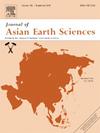Interplay between polyphase deformation and metamorphism of the NW Sanandaj-Sirjan Zone, Hamedan Area, Western Iran
IF 2.4
3区 地球科学
Q2 GEOSCIENCES, MULTIDISCIPLINARY
引用次数: 0
Abstract
Deciphering the interplay between deformation and metamorphism represents the key to unveil the tectono-metamorphic evolution of orogens. Despite the ongoing of high-resolution techniques and the ability to extract important information from small objects or sites, the integration of meso and microstructural analysis and the blasthesis deformation relations represents the starting point for further investigation. The Hamedan region in the Sanandaj-Sirjan Zone of the Zagros orogeny, western Iran, represents a natural laboratory where is possible to observe this interplay. In particulate, this region hosts the Middle Jurassic Alvand plutonic complex intruded into low- to high-grade regional metamorphic rocks. This study identified four stages of ductile deformation (D1–D4) characterized by folds (F1–F4), foliations (S1–S4), and lineations (L2–L4). The development of pre-, syn-, and post-tectonic garnet, andalusite, staurolite, and cordierite porphyroblasts is closely associated with these deformation stages. Type 3 interference patterns among F1, F2, and F3 folds suggest a predominantly coaxial nature for D1, D2, and D3 deformations. Syn-tectonic emplacement of the Alvand plutonic complex during D2 caused significant rotation of structural elements in the host rocks. Our results emphasize the important of unravel the interplay between deformation, metamorphism, to reconstruct the tectono-metamorphic history of the Hamedan region and the emplacement of the Alvand plutonic complex. The plutonism reflects the regional tectonics driven by the subduction of the Neo-Tethys Ocean beneath the Iran microplate. The findings contribute to understanding the complex tectono-metamorphic evolution of the Sanandaj-Sirjan Zone and the broader Zagros orogeny.

伊朗西部哈马丹地区NW Sanandaj-Sirjan带多相变形与变质作用的相互作用
破译变形与变质作用的相互作用是揭示造山带构造变质演化的关键。尽管高分辨率技术和从小物体或地点提取重要信息的能力不断发展,但细观和微观结构分析以及爆炸变形关系的整合代表了进一步研究的起点。位于伊朗西部扎格罗斯造山带Sanandaj-Sirjan区的Hamedan地区是一个可以观察这种相互作用的天然实验室。在颗粒上,该区拥有侵入低至高品位区域变质岩的中侏罗统阿尔万德和深部杂岩。研究确定了韧性变形的四个阶段(D1-D4),其特征为褶皱(F1-F4)、片理(S1-S4)和线理(L2-L4)。构造前、构造同期和构造后石榴石、红柱石、橄榄石、堇青石等斑岩母岩的发育与这些变形阶段密切相关。F1、F2和F3褶皱之间的3型干涉模式表明D1、D2和D3变形主要是同轴的。D2期Alvand岩体的同构造侵位引起了寄主岩中构造元素的明显旋转。我们的研究结果强调了揭示变形、变质作用之间的相互作用,对于重建哈马丹地区的构造变质史和阿尔万德和深部杂岩体的侵位具有重要意义。深部成矿作用反映了伊朗微板块下新特提斯洋俯冲所驱动的区域构造。这些发现有助于认识Sanandaj-Sirjan带复杂的构造变质演化和更广泛的Zagros造山运动。
本文章由计算机程序翻译,如有差异,请以英文原文为准。
求助全文
约1分钟内获得全文
求助全文
来源期刊

Journal of Asian Earth Sciences
地学-地球科学综合
CiteScore
5.90
自引率
10.00%
发文量
324
审稿时长
71 days
期刊介绍:
Journal of Asian Earth Sciences has an open access mirror journal Journal of Asian Earth Sciences: X, sharing the same aims and scope, editorial team, submission system and rigorous peer review.
The Journal of Asian Earth Sciences is an international interdisciplinary journal devoted to all aspects of research related to the solid Earth Sciences of Asia. The Journal publishes high quality, peer-reviewed scientific papers on the regional geology, tectonics, geochemistry and geophysics of Asia. It will be devoted primarily to research papers but short communications relating to new developments of broad interest, reviews and book reviews will also be included. Papers must have international appeal and should present work of more than local significance.
The scope includes deep processes of the Asian continent and its adjacent oceans; seismology and earthquakes; orogeny, magmatism, metamorphism and volcanism; growth, deformation and destruction of the Asian crust; crust-mantle interaction; evolution of life (early life, biostratigraphy, biogeography and mass-extinction); fluids, fluxes and reservoirs of mineral and energy resources; surface processes (weathering, erosion, transport and deposition of sediments) and resulting geomorphology; and the response of the Earth to global climate change as viewed within the Asian continent and surrounding oceans.
 求助内容:
求助内容: 应助结果提醒方式:
应助结果提醒方式:


